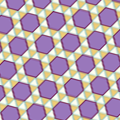File:Academ Periodic tiling where eighteen triangles encircle each hexagon.svg
From formulasearchengine
Jump to navigation
Jump to search

Size of this PNG preview of this SVG file: 600 × 600 pixels. Other resolutions: 240 × 240 pixels | 480 × 480 pixels | 768 × 768 pixels | 1,024 × 1,024 pixels | 2,048 × 2,048 pixels.
Original file (SVG file, nominally 600 × 600 pixels, file size: 1 KB)
This file is from Wikimedia Commons and may be used by other projects. The description on its file description page there is shown below.
Summary
| DescriptionAcadem Periodic tiling where eighteen triangles encircle each hexagon.svg |
English:
Wheher triangular or hexagonal, all tiles of this tessellation are convex regular polygons edge‑to‑edge. Out of the three colours of surfaces, one is specific to the hexagons, whereas one or the other of the lightest two colours fills each triangular tile. Every hexagon adjoins six triangles, three of one colour, three of the other. Every triangle adjoins three tiles: either three triangles or two triangles and one hexagon. A common edge of two adjacent tiles always separates two different colours. This tiling is periodic. All its tiles have the same side length which, multiplied by 7, becomes the side length of a rhombic repetitive pattern. Its sides are parallel to two sides of a triangular tile. Its area is the one of 7 × 7 × 2 = 98 triangles. Such a pattern can contains 5 entire hexagons, four halves of hexagons, plus 7 × 8 = 56 equilateral triangles. So its area can be seen as the area of the following number of triangles: (5 + 4/2 ) 6 + 7 × 8 = 7 (6 + 8). Such a pattern, formed by two equilateral triangles edge‑to‑edge, can be transformed into a regular hexagonal pattern of same area, of which two sides are parallel to the large diagonal of the repetitive rhombus. So this image is classified within Category:Honeycombs (geometry). Français : Qu’ils soient triangulaires ou hexagonaux, les éléments de ce pavage sont tous des polygones réguliers convexes bord à bord. Sur les trois couleurs de surfaces, l’une est propre aux hexagones, tandis que l’une ou l’autre des deux couleurs les plus claires remplit chaque élément triangulaire. Chaque hexagone jouxte six triangles, trois d’une couleur, trois d’une autre. Chaque triangle jouxte trois éléments : soit trois triangles, soit deux triangles et un hexagone. Un côté commun à deux éléments adjacents sépare toujours deux couleurs différentes. Ce pavage est périodique. Tous ses éléments ont la même longueur de côtés qui, multipliée par 7, devient la longueur des côtés d’un motif répétitif en forme de losange. Ses côtés sont parallèles à deux côtés d’un élément triangulaire. Son aire est celle de 7 × 7 × 2 = 98 triangles. Un tel motif peut contenir 5 hexagones entiers, quatre moitiés d’hexagones, plus 7 × 8 = 56 triangles équilatéraux. Ainsi son aire peut être considérée comme celle du nombre suivant de triangles : (5 + 4/2 ) 6 + 7 × 8 = 7 (6 + 8). Un tel motif, formé de deux triangles équilatéraux bord à bord, peut être transformé en un motif hexagonal régulier de même aire, dont deux côtés sont parallèles à la grande diagonale du losange répétitif. Cette image est donc classée dans la catégorie : Nids d'abeilles (géométrie). |
| Date | |
| Source | Own work |
| Author | Baelde |
| Other versions |
 |
| SVG development InfoField | This /Baelde was created with a text editor. |
Licensing
Arthur Baelde, the copyright holder of this work, hereby publishes it under the following license:
This file is licensed under the Creative Commons Attribution-Share Alike 3.0 Unported license.
Attribution: Arthur Baelde
- You are free:
- to share – to copy, distribute and transmit the work
- to remix – to adapt the work
- Under the following conditions:
- attribution – You must give appropriate credit, provide a link to the license, and indicate if changes were made. You may do so in any reasonable manner, but not in any way that suggests the licensor endorses you or your use.
- share alike – If you remix, transform, or build upon the material, you must distribute your contributions under the same or compatible license as the original.
Captions
Periodic tiling by convex regular polygons edge to edge, where all similar tiling elements are isometric: either triangles or hexagons, eighteen equilateral triangles encircling every hexagon.
Pavage périodique par des polygones réguliers convexes bord à bord, où tous les éléments du pavage qui sont semblables sont isométriques : soit des triangles, soit des hexagones, dix‑huit triangles équilatéraux encerclant chaque hexagone.
Items portrayed in this file
depicts
18 June 2013
image/svg+xml
9fd8332840cb5795cb51850818530712edeb3504
1,037 byte
600 pixel
600 pixel
File history
Click on a date/time to view the file as it appeared at that time.
| Date/Time | Thumbnail | Dimensions | User | Comment | |
|---|---|---|---|---|---|
| current | 15:10, 19 November 2022 |  | 600 × 600 (1 KB) | wikimediacommons>Arthur Baelde | Better source code, better image |
File usage
There are no pages that use this file.